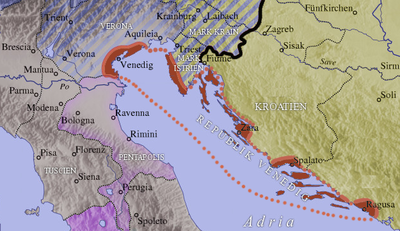March of Istria

The March of Istria (or Margraviate of Istria
History
The settlement area of the ancient
Carolingian march
Charlemagne at first attached the Istrian peninsula to the Lombard Duchy of Friuli, part of the Carolingian
An Istrian margraviate itself first emerged following the death of Duke
After King Pepin had made several attempts to conquer Venice on the Adriatic coast, his father Emperor Charlemagne under the 812 Treaty of Aix-la-Chapelle finally recognised the formal Byzantine control over the city along with Istria, at least its western coast. After this, it falls into obscurity, but perhaps the Byzantines never succeeded in re-establishing their government in the returned territories, if they were actually handed over. The remaining parts of Istria were probably eventually just re-integrated into the Carolingian duchy of Friuli.
When after the deposition of the last Friulian duke
Imperial march
After the German king
There appear counts of Istria late in the 10th century, but Istria together with the
By mid-century most of the Istrian coast had been conquered by Venice. The patriarchs had ceased appointing margraves and had given the remaining interior of the peninsula into the direct control of their .
Habsburg Margraviate
After the secular territory of the patriarchs of Aquileia had been completely conquered by Venice in 1420, most of Istria belonged to La Serenissima. The Austrian House of Habsburg only held a small territory in the interior of the peninsula around Pazin (Mitterburg), which it administered from its Carniolan duchy. The Habsburg rulers nevertheless added the title of a "Margrave of Istria" to their other titles, persisting until the dissolution of the Austro-Hungarian monarchy in 1918.
Venetian Istria fell to the
After the partition of the Illyrian kingdom in 1849, the Margravate of Istria became a subdivision of the Austrian Littoral crown land. It received considerable autonomy as a crown land in its own right with the establishment of the Diet of Istria at Parenzo by the 1861 February Patent.
Margraves
Carolingian March of Istria
- Hunfrid (c. 799), also Duke of Friuli
- John (c. 804), Duke
Margraviate re-established (held by the Counts of Weimar)
- Poppo I (1012–1044), also Margrave of Carniola from 1040
- Ulric I (1060–1070), son of Margrave Poppo I, also Margrave of Carniola
- Henry I(1077–1090)
House of Sponheim
- Engelbert I (1090–1093)
- Burchard (1093–1096)
Counts of Weimar-Orlamünde
- Poppo II (1096–1098), son of Ulric I, Margrave of Carniola since 1070
- Ulric II (1098–1107), brother, also Margrave of Carniola
House of Sponheim
- Engelbert II (1107–1124), son of Engelbert I, also Margrave of Carniola, Duke of Carinthia from 1124
- Engelbert III 1124–1173, son, also Margrave of Carniola
House of Andechs
- Berthold I (1173–1188), also Margrave of Carniola
- Berthold II (1188–1204), son, also Margrave of Carniola, Duke of Merania(as Berthold IV) since 1183
- Henry II (1204–1228), son, also Margrave of Carniola
- Otto I (1228–1234), brother, also Margrave of Carniola, Duke of Merania since 1204, Count Palatine of Burgundy since 1211 (as Otto II)
- Otto II(1234–1248), also Margrave of Carniola, Duke of Merania and Count Palatine of Burgundy (as Otto III)
The title was held afterwards by the Habsburg monarch and the "Margrave of Istria" was included in the
See also
Sources
- .
